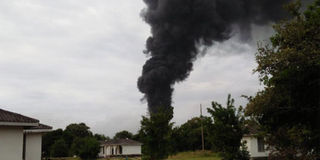Take care lest you fall into terrorists’ trap

Terrorist attack at Magogoni-Naval base in Lamu County on January 5, 2020. The Shabaab utilises the media as part of its propaganda war machine. PHOTO | COURTESY
What you need to know:
- Writing in a manner that tends to question the veracity of the official statement could inadvertently feeding the terrorist propaganda machine.
- Journalists seem not to be aware that they could be part of the arsenal Shabaab seek to deploy in its propaganda war.
The media need to be alert not to play the role of an unwitting gift that kept on giving by amplifying Al-Shabaab propaganda.
Journalists seem not to be aware that they could be part of the arsenal Al-Shabaab seek to capture and deploy in its propaganda war so as to attract funding, sympathy to win over recruits and spread fear and despondency messages far and wide — all for free.
To accomplish this, the Al-Shabaab propaganda machine seeks to capture media attention to spread their macabre message by reporting the activities of the terrorist group in a manner that amplifies both the violence inflicted on the victims and scale up the messages to the world.
Following the Westgate Mall attack in September 2013, newspapers splashed on their front pages images of bloodied faces of injured victims grimacing in pain, which became the ultimate gift to the terror evil planners and sordid executors.
In their reporting, the media should bear a duty of care not to amplify, or worsen, the impact of terrorist activities on the population.
FREE PUBLICITY
That Al-Shabaab is media-savvy and publicity-hungry was on full display on the morning of Sunday, January 5, when the organisation released a statement almost simultaneously as they launched an attack on the military airstrip adjacent to the Manda Bay Naval Base in Lamu County.
This was meticulously planned to be the first version to hit the newsrooms and headline breaking news.
In the statement, Al-Shabaab owned up and claimed credit for the attack. This was almost the time the world was hearing about it for the first time.
By the time any official comment found its way into the newsrooms, Al-Shabaab had enjoyed several hours of free publicity, not to mention the anxiety and dread about what the “hundreds of military personnel” in their statement implied.
A life — civilian or military — needlessly destroyed in a terrorist attack is one too many.
However, it was almost a sigh of relief when the official version of events eventually emerged and the numbers of casualties were nowhere near “hundreds” as the terrorists’ statement had primed listeners, viewers and readers to “anticipate”.
CONFLICTING REPORTS
Then a US official weighed in with a tweet, mourning “American and Kenyan lives lost in the attack”.
The tweet implied that there had been Kenyan casualties that the official State and military outlets had not announced, as the American side reported casualties of a military serviceman and two contractors as well as some injuries.
Six contractor-operated aircraft were also damaged.
On Monday, Interior Cabinet Secretary Fred Matiang’i issued a statement clarifying that there were no Kenyan casualties.
But in a strange turn of events, a reporter went on to pen an article that seemed to create the impression that Dr Matiang’i, and hence the government, was hiding some information.
Writing in a manner that tends to question the veracity of the official statement could cause anxiety among the public and families of the Kenya Defence Forces (KDF) personnel, inadvertently feeding the terrorist propaganda machine.
Mr Mugwang’a, a communications consultant, is a former crime and security reporter. [email protected].




